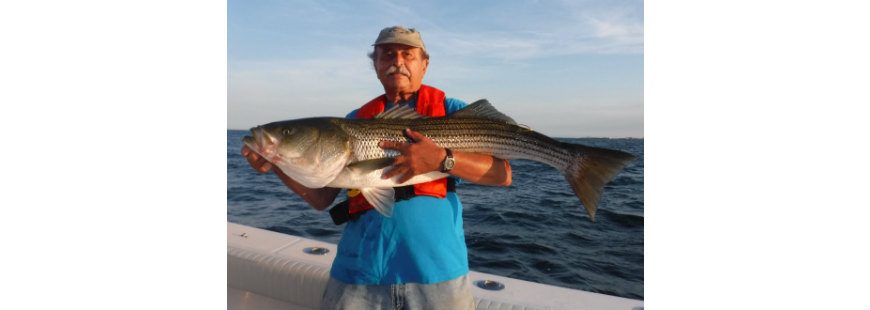Photo:Angler Brian Albano practices catch and release when fishing with Capt. Joe Pagano. Shown with a 30-pound striped bass caught, tagged and released at Pt. Judith Light off Narragansett, RI. Photo via Capt. Dave Monti.
bass catch and release fishing has been the subject of an incredible amount of hearsay and conjecture. Maybe it is because I live on the Chesapeake Bay, but I’ve never heard more misinformation about any fisheries issue. Early on in my conservation career, I was fortunate to meet and become friends with a fish biologist name Rudy Lukacovic. Rudy was a striped bass guru at Maryland DNR and is probably the world’s foremost expert on mortality associated with striped bass catch and release fishing.
Many years ago, I sat with Rudy and Shawn Kimbro in a small meeting room at the Matapeake facility on Maryland’s Eastern shore. Shawn and I were there to learn as much as we could about what happens to a striped bass after it is released. Rudy had worked on catch and release mortality from the Susquehanna to the mid-bay region. He came prepared with charts and graphs. It was an incredible learning experience and one that is worth sharing. So, here’s a bullet point list of how striped bass handle catch and release. Most importantly, these are things you can do as an angler to lessen your impact on the resource. I’d like point out, one more time, there’s a lot of bad information and old wives’ tales out there. Don’t believe them. Instead, this is what you need to know.
- Salinity is the single biggest factor in mortality. If the water has .01ppt salinity, striped bass have incredibly high survival rates. For all of you that fish the ocean, this is great news! If you fish areas that have no salinity, mortality sky rockets to 18% when the water hits 65 degrees. This is why Maryland closes the Susquehanna Flats fishery at 63 degrees. There are times when that can be a completely fresh water environment. This is also why some folks bring up freshwater mortality studies to say catch and release fishermen kill too many fish.
- If you are bait fishing, use a non offset circle hook. Deep hooking results in 50% mortality. This is why you should always use a single hook barbless lure when fishing artificial lures. The damage from bait fishing with trebles and j hooks is not sustainable for the resource. If you use either of these methods, stop.
- If the water has the slightest amount of salinity and the fish is not deep hooked, mortality plummets to .8%.
- During the peak of summer, if there is a greater than 20-degree differential between the air temperature and water temperature, damage can occur to the gills when the fish is lifted from the water. When it is 100 degrees outside, and the water temp is in the 70’s, release the fish in the water.
It is our responsibility to understand these factors and adjust our fishing accordingly. Right now, release mortality is set at 9% coastwide for striped bass. That is an average based on all conditions and methods. Now that you know the truth, you can make a huge difference with a few minor changes. It’s really simple. Don’t fish in fresh water when the water temperature exceeds 65 degrees. Don’t use trebles and J hooks while bait fishing if you are releasing fish. Be a good steward of the resource. Adjust your habits and do something great for the resource.



WOW, this is an article that makes 100% sense. It shows real problems with C&R, not many. but how they can be avoided.
Wood this be true with flounder as well. I know they don’t go into fresh water
Great informative factual read! Thanks
Rudy was a passenger on my boat while conducting the survey at Susquehanna Flats. I’m 100% confident with his findings.